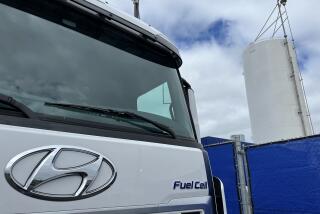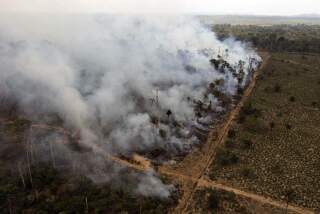Navy Vehicles Will Need an Order of Fries to Go
In a first for the U.S. military, engineers at Naval Base Ventura County plan to recycle used restaurant grease into biodiesel, monitor production costs and test how well the cleaner-burning fuel performs on diesel-powered trucks, generators and machinery.
If successful, mini-refineries could begin popping up on Navy bases across the country to help the military meet tougher smog rules, said Kurt Buehler, project engineer at the Naval Facilities Engineering Service Center in Port Hueneme.
Biodiesel may also be useful in military deployments because refining leftover animal fats and oils into fuel doesn’t require much equipment, Buehler said. Port Hueneme’s entire operation is highly mobile, easily fitting inside a 40-foot shipping container.
“When you go to war, I don’t know how much the generals care that it is less polluting, but they do care about how much fuel they have to ship,” he said.
Although all branches of the military and some federal agencies have been purchasing small amounts of biodiesel, this is the first time the U.S. military will be producing its own, Buehler said.
Last month, Buehler got the OK to move ahead with the program, after meeting with then-acting Secretary of the Navy Hansford T. Johnson. He’ll report the results of his study to the Pentagon in about a year, Buehler said.
Biodiesel advocates are hailing the Navy’s interest as a milestone in gaining acceptance for the alternative fuel. The four branches of the military use a combined 400 million gallons of diesel each year.
If the Navy substitutes biodiesel for even a fraction of that, it would be harder to dismiss it as a fringe fuel, advocates say.
Joe Jobe, executive director of the National Biodiesel Board, called the pilot project a groundbreaking event.
“The Navy is the primary branch of the military charged with protecting our shipping lines for imported petroleum,” said Jobe, who will be present for the base’s Oct. 30 ribbon-cutting ceremony. “That is one of the things they are doing right now in the Persian Gulf. And now the Navy has taken it on itself to turn waste resources into a cleaner-burning form of energy. I see this as a visible and leadership position in doing something about our dependence on imported petroleum.”
The technology for creating biodiesel has been around for decades. But with a plentiful supply of crude and doubts about the fuel’s performance, it did not get much attention until the past decade.
Recent studies have dispelled myths that biodiesel doesn’t work as well as regular diesel and that using it can harm engines, Jobe said. Biodiesel can run in most diesel engines with little alteration and effect on horsepower or fuel efficiency, he said.
“The darn stuff works. You put it in a diesel engine and the operator doesn’t know the difference,” Jobe said. “It just doesn’t have that nasty diesel smoke pouring out of the tailpipe.”
Despite its merits, the Navy’s biodiesel project represents only a drop in the bucket of America’s energy thirst. And when the costs of raw materials, processing and shipping are added up, biodiesel just can’t compete with other fuels, said Daniel Sperling, director of the Institute for Transportation Studies at UC Davis.
“It’s totally cool on so many levels. It’s exactly the type of thing we should be looking at in our society,” he said. “But once you get past recycled oils, the cost of making biodiesel is fundamentally expensive, and you just can’t get around that.”
Biodiesel is made from just about any plant oil or animal fat, but is most often derived from soybean oil. In its pure form, it emits about half of the greenhouse gases produced by standard diesel and reduces particulate matter. It is 94% less likely to cause cancer, according to the U.S. Department of Energy’s Renewable Energy Laboratory.
Purchased commercially, biodiesel can cost at least 20 cents more than regular diesel. But because Port Hueneme is getting its fat for free, costs are expected to be lower.
Port Hueneme engineers plan to produce the alternative fuel in 200-gallon batches. In the first year, they will test about 60,000 gallons on base vehicles, and distribute 20,000 more each to the National Parks Service and Ventura County’s local government.
The agencies will test the product on government fleets and report back to Buehler. While actual production will be relatively minimal, the study is expected to demonstrate that a small refinery could produce up to 1 million gallons of biodiesel a year.
The process is startlingly simple. Vats of yellow grease collected from local restaurants and an on-base fast-food restaurant are dumped into a stainless steel reactor. The glop is then warmed and treated with methanol and lye.
Glycerin produced by the process is poured off and the remainder is ready to use. It takes slightly more than one gallon of cooking oil to produce a gallon of biodiesel, Buehler said.
That’s a lot of French fries. But Buehler has found restaurant owners more than happy to give up their grease, because many now pay haulers to take it away.
The on-base burger franchise is expected to be a major supplier. Local Italian, Chinese and Mexican eateries will also pitch in.
Biodiesel’s aroma subtly changes, depending on what was cooked in the oil.
“When it smells like French fries, you know where it’s been,” Buehler said.
Biodiesel use is up from 500,000 gallons in 1999 to 15 million last year. More than 350 major vehicle fleets nationwide use it. Many of them are governments switching to less-polluting cars.
Experts caution that pure biodiesel is a solvent not compatible with natural rubber found in vehicles built before 1994.
Commercial retailers often sell a blend called B20 (20% biodiesel/ 80% diesel).
Las Vegas and Berkeley are using biodiesel on city cars and buses. Ventura County plans to switch to biodiesel as soon as the project gets underway. The Board of Supervisors is expected to approve participation in the program at today’s meeting.
The county has in recent years sought ways to make its operations more environmentally friendly, said Kay Martin, who is overseeing the project. The biodiesel will likely be used in firetrucks.
Supervisor Linda Parks, who was elected on an environmental platform, said she welcomes the change.
“We have the sources here, and it really is better for air quality,” she said. “We’ll see how it works.”
More to Read
Inside the business of entertainment
The Wide Shot brings you news, analysis and insights on everything from streaming wars to production — and what it all means for the future.
You may occasionally receive promotional content from the Los Angeles Times.











